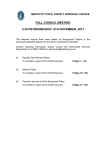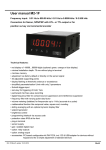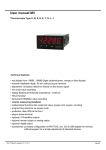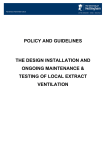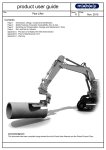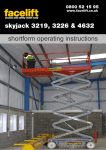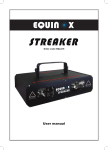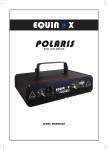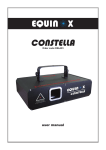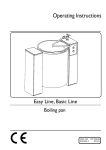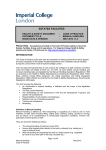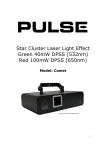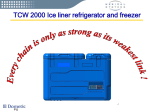Download Passenger-Lifts-and-Hoists-CoP-April-2013 - Workspace
Transcript
ESTATES FACILITIES HEALTH & SAFETY DOCUMENT DOCUMENT TITLE ISSUE DATE & VERSION CODE OF PRACTICE MANAGEMENT of PASSENGER/ GOODS LIFTS & HOISTS APRIL 2013 v1.1 Please Note – This document currently provides general advice only, for specific advice contact Stephen Hughes, Head of Health, Safety & Fire. INTRODUCTION This Code of Practice sets down the standards for the safe management of passenger/goods lifts and hoists, i.e. maintenance, servicing, testing, use etc. It is intended to assist in meeting the requirements of current legislation and sets out procedures on how to achieve safe systems of work. Over and above the general duty of care owed by the College to its staff, students and others under the Health and Safety at Work etc. Act 1974, all work related to lifts and hoist tasks are legislated by the Lifting Operations and Lifting Equipment Regulations 1998 (LOLER) as amended by the Health & Safety (Miscellaneous Amendments) Regulations 2002 apply. This Code of Practice provides the following: 1. A definition and the scope of the applicable Regulations The duties imposed on the employer / employees / other Responsibilities of duty holders and employees Inspection Guidance Competence Overview and Introduction to Passenger Lifts and Hoists Lifting Operations And Lifting Equipment Regulations 1998 (as amended) places duties on any person who uses, supervises, manages or has any control of equipment used for lifting or lowering loads at work (either objects, persons or animals). The regulations state that lifting equipment must be positioned and installed so as to be safe. It must be of adequate strength and stability and clearly marked with its safe working load. In addition, any load parts or attachments used in the lifting operation must also be of adequate strength and marked with any information necessary to ensure their safe use. The regulations require that all lifting operations must be properly planned by a competently trained person, appropriately supervised and carried out in a safe way. Provision and use of Work Equipment Regulations 1998 (as amended) places duties on any person who uses, supervises, manages or has any control of equipment used for work purposes. The regulations state that every employer shall ensure that work equipment is so constructed or adapted as to be suitable for the purpose for which it is used or provided. Passenger / Goods Lifts & Hoists. Code of Practice Page 1 of 11 April 2013 Every employer shall ensure that work equipment is used only for operations for which, and under conditions for which, it is suitable. The regulations require that work equipment is maintained in an efficient state, in efficient working order and in good repair and any maintenance carried out is logged. The regulations also require suitable inspections at regular intervals if machinery is likely to suffer from deterioration or if work equipment depends on the installation conditions. 2. Duties Imposed on the Employer/Employees/Others The Lifting Operations and Lifting Equipment Regulations 1998 (LOLER) introduced new requirements for the safe provision and use of lifting equipment. Regulation 9 of LOLER requires that all lifts provided for use in work activities are thoroughly examined by a competent person at regular intervals. This applies to lifts and hoists used to lift people or loads. Estates Facilities have a responsibility to ensure that all operations involving passenger lifts and hoists that could result in injury are assessed and adequately controlled. To this end the Estates Facilities should appoint a suitably competent person to carry out the actions below. Therefore Estates Facilities management shall ensure that; A suitable and sufficient risk assessment is carried out involving passenger lifts, goods lifts and hoists. Lifting equipment should be inspected if the risk assessment identifies any significant risk to operators and others from the equipment's installation or use. The result of the inspection should be recorded and this record should be kept at least until the next inspection of that equipment. Lifting equipment that requires inspection should not be used, unless the inspection has taken place. Where it leaves the Estates Facilities undertaking, or is obtained from another (e.g. a hire company) it should be accompanied by physical evidence of the last inspection, such as an inspection report. 3. Inspection Guidance The level of inspection required will depend upon the type of lifting equipment being used, its use, and the conditions to which it is exposed. This will be determined through the risk assessment process and the use of manufacturer’s guidelines and, recommendations. Any inspection should concentrate on the safety-related parts which are necessary for the safe operation of the lifting equipment. Further guidance is provided in Appendix 2 & 3 of this Code of Practice, however in summary the types of inspections required include: Visual checks before use (e.g. pre-checks of any hoists erected) Weekly/monthly inspections (e.g. monthly lift servicing by appointed lift contractor) More extensive thorough examinations (e.g. six monthly lift insurance inspections) Thorough examinations will need to be undertaken by a competent person. The definition of what constitutes a ‘competent person’ is identified in Section 5 below. Such examinations will involve a systematic and detailed inspection of the lift and all its associated equipment. To determine the extent of any thorough examination, the competent person will assess the risks, considering factors such as where the lift/hoist is to be used, frequency of use, age and condition, and the weight of loads to be lifted. In summary it is a legal requirement that all lifts are thoroughly examined: After substantial and significant changes have been made; At least every six months if the lift is used at any time to carry people, every twelve months if it only carries loads (good lifts); and Passenger / Goods Lifts & Hoists. Code of Practice Page 2 of 11 April 2013 4. Following ‘exceptional’ circumstances such as damage to, or failure of, the lift, long periods out of use or a major change in operating conditions which is likely to affect the integrity of the equipment. Responsibilities of Duty Holders and Employees Estates Facilities have a responsibility to ensure that all operations involving passenger lifts, good lifts and hoists, which could result in injury, are assessed and adequately controlled. To this end Estates Facilities should appoint a suitably competent person to carry out the actions below. maintaining the lift so that it is safe to use; selecting and instructing the competent person; ensuring that the lift is examined at statutory intervals (every six or twelve months) or in accordance with an examination scheme drawn up by a competent person; keeping the competent person informed of any changes in the lift operating conditions which may affect the risk assessment; making relevant documentation available to the competent person, e.g. manufacturer’s instructions and maintenance records; acting promptly to remedy any defects; ensuring that all documentation complies with the Regulations; and record keeping. Employees and students have a responsibility not to undertake any activities on passenger lifts and hoists that may cause themselves or others harm and adhere to the information, instruction and training provided. They must immediately bring instances having the potential to cause harm to the attention of their immediate line manager. 5. Competence A competent person is someone who has sufficient technical and practical knowledge of the lift or hoist to be able to detect any defects and assess how significant they are. It is also important that the competent person is sufficiently independent and impartial to allow them to make an objective assessment of the lift or hoist. For this reason, it is not advisable for the same person who performs routine maintenance to carry out the thorough examination, as they are then responsible for assessing their own work. The College will utilise an external company to act as the competent person, ensuring they meet the above criteria. The competent person will understand what is meant by a ‘thorough examination’ and what the law requires. Accreditation by the United Kingdom Accreditation Service to the relevant standard (BS EN 45004) is an indication of the competence of an inspection body. Passenger / Goods Lifts & Hoists. Code of Practice Page 3 of 11 April 2013 Appendix 1 - Guidance Documents Available Simple guide to the Lifting Operations and Lifting Equipment Regulations (HSE) and Safety Assessment Federation’s (SAFed) Lift guidelines These guides provide information about the legal requirements of the Lifting Operations and Lifting Equipment Regulations 1998 (LOLER) which came into force on 5 December 1998. It gives a general indication of some of the main requirements of the Regulations. The guidance documents are available at the following links: http://www.hse.gov.uk/pubns/indg290.pdf http://safed.co.uk/download/MTI4 This website provides information and assistance regarding the Lifting Operations and Lifting Equipment Regulations. It outlines the regulations and provides a simple guide to the equipment which this applies to and what the regulations require employers to carry out. Passenger / Goods Lifts & Hoists. Code of Practice Page 4 of 11 April 2013 Appendix 2 – Thorough Examinations A thorough examination is a systematic and detailed examination of the lift and all its associated equipment by a competent person. Its aim is to detect any defects which are, or might become, dangerous, and for the competent person to report them to the duty holder (Imperial College London) and, if appropriate, the enforcing authority (the Health and Safety Executive or local authority) so that appropriate remedial action can be taken. To determine the extent of the thorough examination, the competent person will assess the risks, considering factors such as where the lift will be used, frequency of use, age and condition, the weight of loads to be lifted, etc. A thorough examination may include some testing, if the competent person considers it to be necessary. The competent person will normally determine what tests are required, taking account of the relevant guidance and standards, and Imperial College will insist on this approach. Thorough examination may also be supplemented by inspection. Inspections should be carried out at suitable intervals between thorough examinations by a competent, trained person. Inspections would normally include visual and functional checks, e.g. that the alarm interlocks operate correctly and lift doors cannot be opened from the landing side. Thorough examination should not be confused with preventive maintenance, although they have some elements in common. Preventive maintenance usually involves replacing worn or damaged parts, topping up fluid levels and making routine adjustments to ensure risks are avoided. Thorough examination may act as a check that maintenance is being carried out properly, but is not intended to replace it. Thorough examination should include the following: landing and car doors and their interlocks; worm and other gearing; main drive system components; governors; safety gear; suspension ropes; suspension chains; overload detection devices; electrical devices (including earthing, earth bonding, safety devices, selection of fuses, etc); braking systems (including buffers and overspeed devices); and hydraulics. This list is not exhaustive. More detailed guidance can be found in the Safety Assessment Federation’s (SAFed) Lift guidelines. http://safed.co.uk/download/MTI4 Passenger / Goods Lifts & Hoists. Code of Practice Page 5 of 11 April 2013 Frequency and Conditions for the Thorough Examination The law requires that all lifts when in use should be thoroughly examined: after substantial and significant changes have been made; at least every six months if the lift is used at any time to carry people, every twelve months if it only carries loads, or in accordance with an examination scheme; and following ‘exceptional circumstances’ such as damage to, or failure of, the lift, long periods out of use or a major change in operating conditions which is likely to affect the integrity of the equipment. Note: When first installed, new lifts do not require any initial thorough examination as long as they have been manufactured and installed in accordance with the Lifts Regulations 1997 and have a current declaration of conformity, i.e. made not more than twelve months before. A new lift is one where: no lift previously existed; an existing lift has been completely replaced; or only the existing guide rails and their fixings or the fixings alone have been retained. Thorough Examination Documentation The competent person (Lift Contractor/Insurance Company) is legally required to send Imperial College a written and signed report of the thorough examination as soon as practicable. This should normally be within 28 days, but if there is a serious defect which needs to be addressed, the report should be received much sooner. If the competent person identifies a defect which presents an ‘existing or imminent risk of serious personal injury’ they are also legally required to send a copy of the report to the enforcing authority. By law, the report must contain certain information, specified in LOLER. In summary, it should: identify the equipment examined (serial number, make, etc), the employer and the premises; give the date of the last thorough examination and specify when the next one should take place; specify the safe working load of the lift; give the reason for the thorough examination (i.e. following installation, according to an examination scheme, statutory interval, etc); identify any defect which is or may become a danger to people; give the details of any repair, renewal or alteration required to remedy the defect and the date by which it should be undertaken; give details of any tests carried out; give details of the person carrying out the report and the person validating the report on their behalf. If the report does not contain all the information above, Imperial College should not accept it, as this may place the College in breach of the law. In this scenario the College is to try and resolve the matter with the competent person, but if this is unsuccessful the College should contact the local enforcing authority for advice. Passenger / Goods Lifts & Hoists. Code of Practice Page 6 of 11 April 2013 Appendix 3 – Inspections Frequency and Conditions for Inspections Where the safety of lifting equipment depends on the installation conditions, it should be inspected after installation and before first use, and after reassembly at any new site / location at suitable intervals. Where lifting equipment is exposed to conditions causing deterioration liable to result in dangerous situations. Each time exceptional circumstances (e.g. major modifications, known or suspected serious damage, substantial change in the nature of use) are liable to have jeopardised the safety of the lifting equipment. What the Inspection Should Cover This will depend on type of lifting equipment, its use and the conditions to which it is exposed. This should be determined through risk assessment and take full account of any manufacturer's recommendations. The advice of others, such as trade associations and consultants, as well as other sources like published advice on health and safety, may also be helpful. An inspection should concentrate on those safety-related parts which are necessary for the safe operation of lifting equipment and, in some cases, this may require testing or dismantling. However, not all safety-critical features on a particular item of lifting equipment may require inspection at the same intervals. An inspection can vary in its extent, as the following demonstrate: quick visual checks before use weekly/monthly checks more extensive examinations, undertaken every few months or longer Records are not normally required to be made for the simplest pre-use checks. Passenger / Goods Lifts & Hoists. Code of Practice Page 7 of 11 April 2013 Appendix 4 – Guidance notes Guidance note Guidance note for: Use of Genie Lift Personnel Training Employees in team of two General H&S induction, appropriate professional qualifications, site induction IPAF training Plant, Equipment and Materials Work Equipment and Plant Genie Lift Materials Dependant on task being undertaken Personal Protective Equipment Harness and lanyard Hazards Relevant Assessments Falls from height, physical injury Guidance Undertake pre – inspection check (attached) 1. Perform function test 2. 3. Both feet must be firmly on the platform and the floor kept free of clutter. No sitting, standing or climbing on the bucket walls. Keep hands and fingers away from pulleys and carriages. Avoid leaning ladders against the Genie lift. Do not leave the machine unattended while loaded. 4. 5. Avoid standing underneath the Genie lift while the bucket is raised. Make sure there are no obstructions below when lowering the bucket. Do not use the lift to raise heavy equipment loads and do not exceed the load capacity of 300 pounds. Do not adjust outriggers with a raised or occupied platform. Avoid operating the Genie lift outside in heavy wind, snow or rain. If the Genie lift begins to sway, immediately lower the bucket. Do not operate near or under low electrical lines. Passenger / Goods Lifts & Hoists. Code of Practice Page 8 of 11 April 2013 Pre-Inspection Checklist Do Not Operate Unless: You learn and practice the principles of safe machine operation contained in the operator’s manual. Avoid hazardous situations. Always perform a pre-operation inspection. Know and understand the pre-operation inspection before going on to the next section. Always perform the function tests prior to use. Inspect the workplace. Only use the machine as it was intended. Be sure that the operator’s, safety and responsibilities manuals are complete, legible and in the storage container located on the platform. Be sure that all decals are legible and in place. Check for battery fluid leaks and proper fluid level. Add distilled water if needed. See Maintenance section of the operator’s manual. AC & DC models: Check for hydraulic oil leaks and proper oil level. Add oil if needed. See Maintenance section of the operator’s manual. RT base models: Check for proper tire pressure. Add air to tires if needed. See Maintenance section of the operators manual. Air models: Check the oil level of the airline lubricator. See Maintenance section of the operator’s manual. Air models: Check the oil lubricator canister drip rate. Adjust as needed. See Maintenance section of the operator’s manual. Air models: Check the air filter/regulator canister. Drain water as needed. See Maintenance section of the operator’s manual. Check the following components or areas for damage, improperly installed or missing parts and unauthorised modifications: Electrical components, wiring and electrical cables AC & DC models: Hydraulic power unit, hoses, fittings and cylinder Air models: Air power unit, airlines, fittings and cylinder Platform entry mid-rail or gate Sequencing cables and pulleys Lifting chains and idler wheels Nuts, bolts and other fasteners Mast columns and counterweight Breather cap Outriggers, levelling jacks and footpads Adjustable glide pads Check entire machine for: Dents or damage Corrosion or oxidation Cracks in welds or structural components Inspect and clean battery terminals and all battery cable connections. Be sure that all structural and other critical components are present and all associated fasteners and pins are in place and properly tightened. Passenger / Goods Lifts & Hoists. Code of Practice Page 9 of 11 April 2013 Guidance note Guidance note for: Use of Scissor Lift Personnel Training Employees in team of two General H&S induction, appropriate professional qualifications, site induction IPAF training Plant, Equipment and Materials Work Equipment and Plant Scissor lift Materials Dependant on task being undertaken Personal Protective Equipment Harness and lanyard Hazards Relevant Assessments Falls from height, physical injury Sequence of Tasks Undertake pre – inspection check (attached) 6. Perform function test 7. 8. Perhaps the biggest risk in using scissor lifts lies in the possibility of a tip-over. Because the lift raises straight up off a wheeled base and has such weight at the top, it can easily roll under the wrong conditions. Unlike a standard ladder, the scissor lift does not have anything to lean on to support its full weight at an angle; safely evaluate the area on which you position the lift. Set up your lift on completely flat ground devoid of any holes or bumps. Additionally, place your scissor lift on solid ground; soft ground can give way under the weight, and even the slightest shift in slope can cause an extended lift to tip sideways and throw you out. Most heavy-duty models also come equipped with extendable support arms; extend them to their fullest capacity, and secure them firmly and flatly against the ground. If even one of these arms does not lay flat on the ground when extended and lowered, do not operate the lift. 9. To avoid a fall, always remain on the basket floor itself and refrain from trying to stand on the railings or anywhere else. Though all newer models of lifts should have fully insulated buckets, make frequent checks to ensure that the entire lift remains in good condition, well insulated and free from threat of electrocution---a common threat when using scissor lifts near wiring or power lines. Finally, when working on or near any power lines or powerful wiring, de-energize the lines completely or use the proper equipment to handle them. Tell anyone on the ground nearby to keep a safe distance from the lift to avoid accidental electrocution should the lift's insulation fail. Passenger / Goods Lifts & Hoists. Code of Practice Page 10 of 11 April 2013 Pre Inspection Checklist Do Not Operate Unless: You learn and practice the principles of safe machine operation contained in this operator's manual. Avoid hazardous situations. Always perform a pre-operation inspection. Know and understand the pre-operation inspection before going on to the next section. Always perform function tests prior to use. Inspect the workplace. Only use the machine as it was intended Pre-operation Inspection Be sure that the operator’s, safety and responsibilities manuals are complete, legible and in the storage container located in the platform. Be sure that all decals are legible and in place. Check for hydraulic oil leaks and proper oil level. Add oil if needed. See Maintenance Section in the user manual Check for battery fluid leaks and proper fluid level. Add distilled water if needed. See Maintenance section in the user manual. Check the following components or areas for damage, improperly installed or missing parts and unauthorized modifications: Electrical components, wiring and electrical cables Hydraulic hoses, fittings, cylinders and manifolds Battery pack and connections Drive motors Wear pads Tires and wheels Ground strap Limit switches, alarms and horn Alarms and beacons (if equipped) Nuts, bolts and other fasteners Platform entry chain or gate Brake release components Safety arm Platform overload components Pothole guards Platform extension Scissor pins and retaining fasteners Platform control joystick Check entire machine for: Cracks in welds or structural components Dents or damage to machine Excessive rust, corrosion or oxidation Be sure that all structural and other critical components are present and all associated fasteners and pins are in place and properly tightened. Be sure side rails are installed and bolts are fastened. Be sure that the chassis trays are closed and latched and the batteries are properly connected. Note: If the platform must be raised to inspect the machine, make sure the safety arm is in place. Passenger / Goods Lifts & Hoists. Code of Practice Page 11 of 11 April 2013











